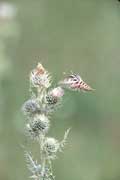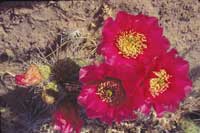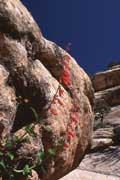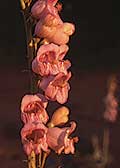 From early spring to the start of fall, blooms of wildflowers and shrubs grace the desert landscape. There is a progression of flowers that follows the spiral of the seasons, also proceeding upwards in elevation as the months peel off.
From early spring to the start of fall, blooms of wildflowers and shrubs grace the desert landscape. There is a progression of flowers that follows the spiral of the seasons, also proceeding upwards in elevation as the months peel off.
Most wildflowers and shrubs are insect or bird pollinated. Trees like the Utah juniper, Fremont’s cottonwood and pinyon pine use the wind to carry out their pollination strategy. During this pollen producing period, small puddles may be edged in yellow pollen that has fallen short of their intended target. The trees produce vast quantities of pollen and base their strategy solely on chance.
Wildflowers and shrubs have charted a different pollination course. Relying upon insects or birds to do the pollen transfer, these plants invest some energy in flower form, and pollen and nectar rewards. In return, the pollinators are a little more faithful to the flowers.
 Many shrubs entice pollinators with sweet aromas which smell of the promise of nectar. At times this perfume wafts about on desert breezes and can be so thick that you smell the sweetness even at 50 mph. One such sweet-smelling shrub is the cliffrose. Often these large shaggy shrubs are cloaked with blossoms and choked with bees. In years with abundant summer rainfall, these shrubs may enter into a second bloom period and once again sweeten the desert with their scent.
Many shrubs entice pollinators with sweet aromas which smell of the promise of nectar. At times this perfume wafts about on desert breezes and can be so thick that you smell the sweetness even at 50 mph. One such sweet-smelling shrub is the cliffrose. Often these large shaggy shrubs are cloaked with blossoms and choked with bees. In years with abundant summer rainfall, these shrubs may enter into a second bloom period and once again sweeten the desert with their scent.
Prickly pear cacti bloom later in the season than other cacti like the hedgehog or claret cup. Their jointed pads are different than the barrel shapes of the other two, but their blossoms are just as spectacular.
 Again, depending upon spring moisture, the prickly pears may be loaded with blossoms, the pads swollen with fluid and flush with new growth. Their colorful blooms surround a sea of stamens loaded with pollen. A glance down into these flowers often reveals a small safari of insects plowing through the stamens gathering pollen and nectar. Beetles, flies, wasps and other insects migrate through the flowers.
Again, depending upon spring moisture, the prickly pears may be loaded with blossoms, the pads swollen with fluid and flush with new growth. Their colorful blooms surround a sea of stamens loaded with pollen. A glance down into these flowers often reveals a small safari of insects plowing through the stamens gathering pollen and nectar. Beetles, flies, wasps and other insects migrate through the flowers.
There are other plants that tend to be a little more selective in terms of pollinators. Many of the penstemon have flower shapes that attract particular pollinators – hummingbirds in the case of the Eaton’s penstemon and bumblebees for the Palmer’s penstemon.
The long, red tubular flowers of the Eaton’s penstemon are angled somewhat downward so that hummingbirds can hover near the flowers and investigate them for nectar. As the bird’s bill probes the flower, pollen is knocked off onto the bird’s head. Upon visiting other flowers, some of this pollen rubs off onto another flower’s stigma thus completing the process of pollination.
 In the case of the Palmer’s penstemon, their flowers are more rounded and designed to attract bees which can burrow into the flowers and collect pollen. Elongated stalks thick with blooms entice these bees to work their way up or down the stems, visiting numerous flowers and enhancing the plant’s chances of pollination.
In the case of the Palmer’s penstemon, their flowers are more rounded and designed to attract bees which can burrow into the flowers and collect pollen. Elongated stalks thick with blooms entice these bees to work their way up or down the stems, visiting numerous flowers and enhancing the plant’s chances of pollination.
So in spots like Natural Bridges National Monument, Wilson’s Mesa, Kigalia Point and Beaver Mesa, the abundance and attraction of desert wildflowers continues in June. Some lower elevation sites will continue to produce flowers through the summer, but the desert heat will takes its toll by this time. So June doesn’t mean to stop looking for flowers. Just head up a little higher in elevation to seek out their blooms.